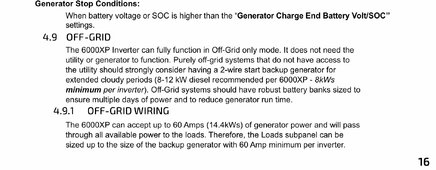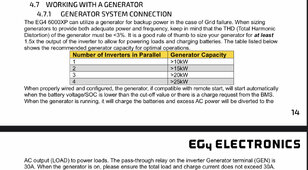JBoffgrid2022
New Member
- Joined
- Oct 28, 2022
- Messages
- 153
Hello!
Looking for some advice on generator sizing for (2) EG4 6000XP's in parallel. I have a propane powered Kohler 12kW RES off grid generator installed at my off grid camp and would hate to have to sell that and install a new larger generator if I don't have to. The total size of the two inverters I am installing is 12kW. The manual that came with the inverter only gives instructions for one inverter. It mentions two things:
-1. Get a generator that is 150% larger than the inverter (this would equate to a 18kW generator for both inverters if my understanding and math is correct).
-2. Connect the generator input lines to all inverters in parallel. This is what is making me think I will need a bigger generator to properly supply enough power to charge the battery bank and supply the load to the main panel/house.
Any advice would be appreciated! Thank you.
Looking for some advice on generator sizing for (2) EG4 6000XP's in parallel. I have a propane powered Kohler 12kW RES off grid generator installed at my off grid camp and would hate to have to sell that and install a new larger generator if I don't have to. The total size of the two inverters I am installing is 12kW. The manual that came with the inverter only gives instructions for one inverter. It mentions two things:
-1. Get a generator that is 150% larger than the inverter (this would equate to a 18kW generator for both inverters if my understanding and math is correct).
-2. Connect the generator input lines to all inverters in parallel. This is what is making me think I will need a bigger generator to properly supply enough power to charge the battery bank and supply the load to the main panel/house.
Any advice would be appreciated! Thank you.




